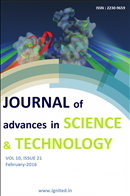A Research about Enhancement of Liquid Crystal Nanoparticle Composites: Electrical and Optical Studies Exploring the Enhancement of Liquid Crystal Nanoparticle Composites for Optical Processing Applications
Main Article Content
Authors
Abstract
Liquid crystals possess large dielectric and electro-optical properties owing to their large anisotropy coupled with the collective molecular reorientation. Doping dyes and nanoparticle into liquid crystals increases their optical responses significantly due to increased induced intermolecular torque, and other guest-host effects. The guest-host mixtures can be employed in display applications, optical storage devices.We investigate the nonlinearity of a liquid crystal cell doped with gold nanoparticles by considering their selective absorption. Such nonlinearities are promising for optical processing applications and optical limiters. Systems displaying thermal nonlinearities are particularly attractive as the maximum nonlinearity may occur in the absence of an applied field and additionally this nonlinearity can be controlled by the reorientation of the liquid crystal.Due to the increased popularity of fast response display, the driving force to make high-speed switching liquid crystal (LC) material is raised. Doping nanoparticles such as carbon nanotubes (CNTs) in LC material is one of the methods to improve the display performance. Recently, many studies reported that enhancement of electro-optical (EO) performance was achieved by LC nanocomposites. The attraction of the hybrid system is not only the advance in EO performance, but also the alignment of CNTs. The disordered nature of CNTs makes it hard to expose the excellent properties and the self-ordered nature of LC material perfectly fit in this problem. Moreover, with LC acts as host, the CNTs orientation can be manipulated by external electric or magnetic field. This creates a promising future for novel nano-devices. On the other hand, there are doubts or questions on the stability of the nanocomposites and optimization of the sonication parameters and CNTs concentration that needed to be addressed before the mass production in the industry.Nanoparticles (NPs) have emerged as extremely promising materials to alter and improve the properties of liquid crystals (LCs) used, for example, in device applications. In this paper, we summaries recent work from our lab that aims to provide a fundamental understanding of structure–property and composition–property relationships governing LC–NP interactions, which may point to new directions for major improvements in the efficiency of LCs used in display applications. A variety of LC hosts (phases) doped with surface-functionalized gold NPs have been systematically studied ranging from one-dimensionally ordered nematic over two-dimensionally ordered smectic to three-dimensionally ordered columnar phases. Significant progress with respect to LC–NP interactions was made for NP-doped nematic phases. Here, the observation of an unusual texture for Au NP-doped nematic LCs, that is, the formation of birefringent stripe textures and the induction of homeotropic alignment of the nematic LC similar to chiral finger (or fingerprint) textures, provided the basis for numerous experimental studies using Au NPs with different core sizes and surface functionalities.
Downloads
Download data is not yet available.
Article Details
Section
Articles

